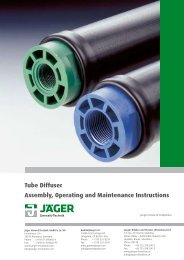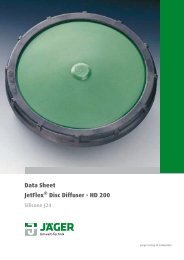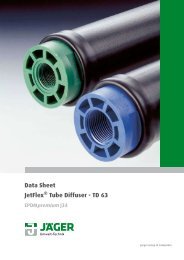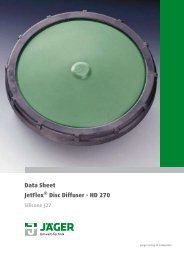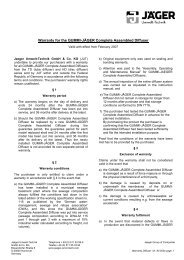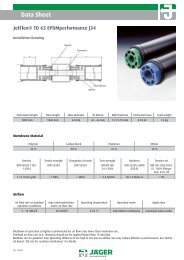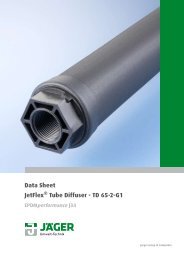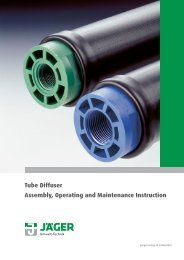Disk Diffuser - Jäger Umwelt-Technik GmbH & Co. KG
Disk Diffuser - Jäger Umwelt-Technik GmbH & Co. KG
Disk Diffuser - Jäger Umwelt-Technik GmbH & Co. KG
You also want an ePaper? Increase the reach of your titles
YUMPU automatically turns print PDFs into web optimized ePapers that Google loves.
Specifications7 Operating Instructions7.1 Start-Up InstructionsPrior to start-up clean the aeration tank from debris like stones, wooden pieces, metal parts etc.Keep the time between assembly and filling of the basin as short as possible. Ohterwise take thefollowing steps:• Do not perform any work near the diffuser or above the aeration tank, which may damagediffusers; e.g. painting, welding, concrete sealing etc.• Safeguard diffusers from falling parts.• Fill tank with clean water approximately 20 cm above diffusers. Start blowers for 5 - 10minutes and check for obvious leaks. Have blowers stopped and immediately check again for smaller andhidden leaks when airflow seizes. Tiny leaks may be detected now with lower turbulences.• Start wastewater treatment now or raise water level to 1 m with clean water.• Operate blowers for 10 minutes at medium speed at least once a day.• Raise water level even more if temperatures drop below freezing. (~20 cm additional water foreach degree Celsius below zero.)• Prior to SOTE testing allow diffusers to run at maximum design airflow for one week (minimum 3days).7.2 Regular OperationDuring regular operation adjust airflow of diffusers to maintain the required oxygen level in theaeration tank. Keep airflow within recommended range of diffusers (see data sheets).Too high an airflow reduces efficiency and may eventually damage the diffuser membraneirreversibly. Very low airflow rates may cause uneven oxygen supply and excessive fouling of themembrane surface. Water temperature should range from 5°C to 35°C; air temperature at the diffusershould not exceed 60°C. <strong>Co</strong>nsult JUT in case either temperature is higher.Air from blowers must not contain oil, dust, or solvents. Use dust filters according to DIN EN 779 (>80%,better >90% dust removal, class G3 or G4, respectively.) Air going into the blowers must correspondto local regulations (see e.g. TA-Luft for Germany).<strong>Diffuser</strong> headloss should be monitored continuously. An increase of more than 10 mbar/year may indicatea clogging problem caused by deposits of carbonates, iron-salts, or biological growth. See section7.4 for details of cleaning. Inspect diffusers visually on a regular basis at least once a year.



